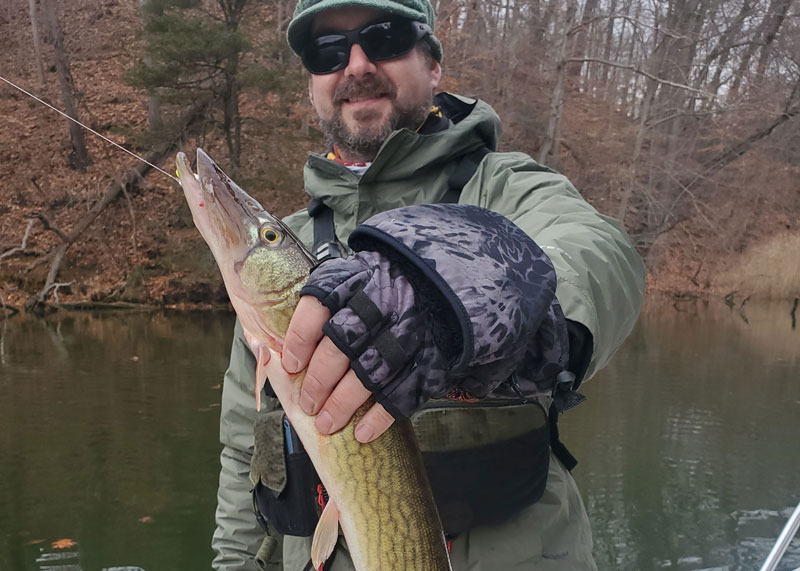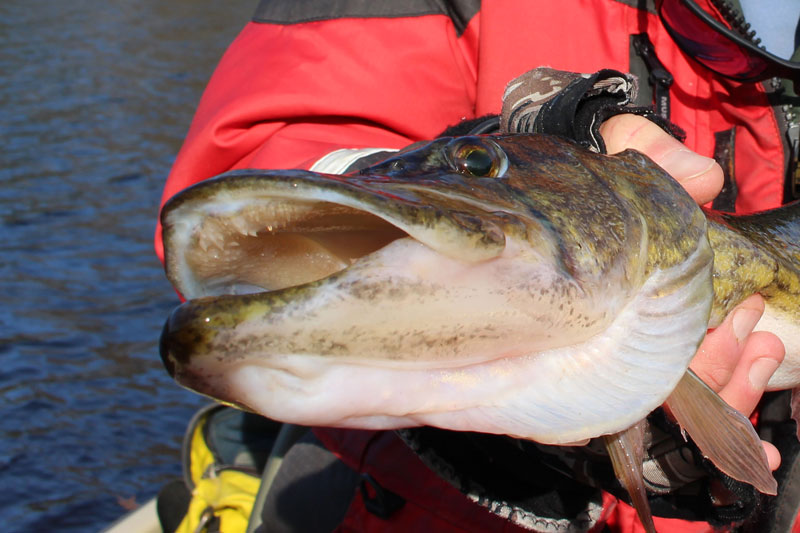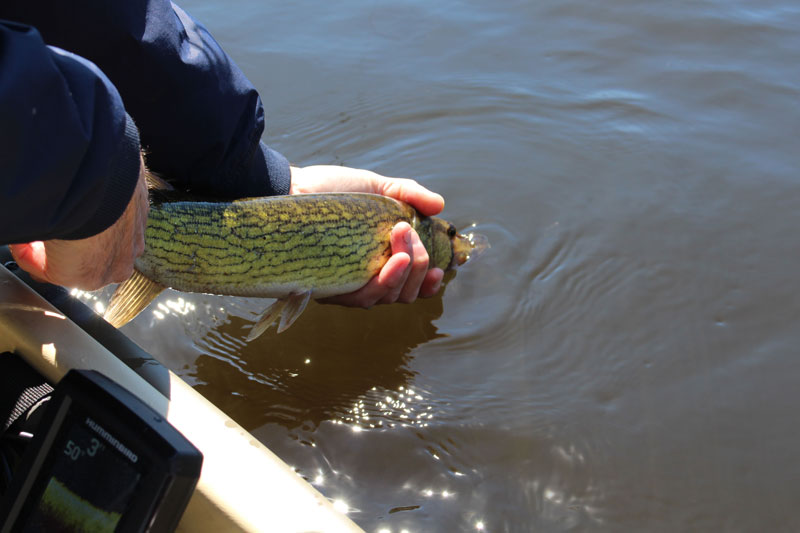Pickerel are one of the handful of species of fish in the Mid-Atlantic region which hit their stride during the cooler months of the year, in creeks, rivers and lakes accessible by boat, via kayak fishing, or casting from the bank. From now through March pickerel fishing will shine, and these toothy critters will provide nonstop action in fishing venues throughout the area.

What are Pickerel Fish?
Pickerel are long tubular-shaped fish in the pike family. There are actually several species of pickerel, but the chain pickerel, which is native to the Atlantic coast, its tributaries, and impoundments, is the one commonly seen in the Mid-Atlantic states. Grass pickerel live to the west from the Great Lakes down to Mississippi, and while the redfin pickerel can be found in Delaware, Maryland, and Virginia, its small size (a foot-long redfin is a monster) and lower population numbers mean it’s rarely seen by anglers.
Chain pickerel have a chain-like pattern going down their greenish sides, a single dorsal fin far back near the fish’s tail, and a prominent duck-like bill which is jam-packed with very sharp teeth. Warning: keep your fingers away from the pickerel’s mouth, because it can cause some serious damage.
Pickerel Fun Facts
- Pickerel normally weigh between one and three pounds and measure from a foot or so to two feet in length, but they can get larger.
- Pickerel can lay up to 50,000 eggs at a time. But once those eggs are laid the babies are on their own, as the pickerel don’t guard them at all.
- A pickerel can live for up to a decade.
- Pickerel thrive in shallow, weedy water, and are rarely found in depths of more than 10 or 12 feet.
- This species lives in both tidal and nontidal waters, and can be found in virtually every Chesapeake Bay tributary river as well as many lakes and ponds.
- The CCA-Maryland Winter Pickerel Championship runs all winter long and is a catch-photo-release competition which adds an element of excitement to your winter fishing endeavors.
Record Pickerel
Delaware – The state record for Delaware is seven pounds, 13 ounces, and was just set in 2022.
Maryland – In Chesapeake waters, the state record sits at six pounds, five ounces, for a fish caught in the Susquehanna all the way back in 1975. The freshwater record is eight pounds even, and was caught in Salisbury in 2015.
Virginia – Seven pounds, 12 ounces sets the mark for pickerel in Virginia.
Where to Find Pickerel
Pickerel are ambush predators which will commonly sit motionless in or near cover, then dart out to pounce on their meals. Since they like relatively shallow waters this means they can often be found along shorelines hiding next to fallen trees and similar structure. However, they also like to hide in weedbeds. In ponds or lakes with weedbeds in three to eight or so feet of water, you’ll often find the majority of the pickerel sitting in the weeds.
It's important to note that pickerel may be found in very different areas, depending on the environment. In tributary waters with few weedbeds and developed shorelines, for example, pickerel will often be found next to piers and pilings. And in deep lakes with few shallow flats that support weed growth, points can be a form of structure they gravitate to.
How to Catch Pickerel
Pickerel will hit many types of lures, including spoons, plugs, and jigs. They particularly like striking inline spinners with trailer lures, and lures with spinners attached such as Roadrunners or under-spins. But for simplicity and effectiveness it’s tough to beat a live minnow suspended under a bobber, with the depth set so the bait is just a few inches above any weed growth that may be present. Slow trolling lures and/or minnow for pickerel can also be a deadly tactic, and is often one favored by kayak anglers.
For in-depth how-to articles that dig deep into different tactics and tackle used for pickerel, read:
- Fishing Tactics for Chain Pickerel
- Kayak Fishing for Pickerel
- Slow Trolling for Pickerel
- Winter Pickerel Fishing tactics that Work
Also check out these pickerel fishing videos:
Pickerel Fishing Gear
While you can use whatever rod and reel you like for pickerel fishing, most anglers will opt for spinning or casting gear in the eight- to 15-pound class. Leader choice, however, is a bit more critical. Remember those teeth? If a pickerel gets your lure or bait into its mouth there’s a very good chance it will cut you off, especially if you have light leader. Sharpies will usually start at a minimum of 12-pound test but often go as high as 20-pound test to minimize bite-offs. Pickerel aren’t particularly leader-shy, so while a few might not strike when you use a heavy leader, you’ll still get plenty of bites most of the time.
Another important piece of pickerel fishing gear is a lip-gripper. Since they’re so toothy (and quite slimy), it can be very difficult to control a pickerel, and a lip-gripper is usually the best way to hold them while you remove the hook and snap off a picture or two.

I Caught a Pickerel: Now What?
As long as you abide by size, creel, and seasonal regulations in your area, it’s legal to keep and eat pickerel, and they do have a very sweet, flaky white meat. However, very few anglers take them home for dinner. Pickerel have numerous “pin bones” running up and down through their body, and it’s hard to remove them without ruining the fillets. So, most people simply catch-and-release fish for them. None of us want to harm fish we aren’t harvesting, so applying best catch-and-release practices is important:
- Land the fish with a net that has “fish safe” rubberized or rubber-coated mesh, not knotted nylon. Knotted nylon can scrape the fish’s slime away, which can lead to infections.
- Never use a dry towel or even dry hands to handle the fish. Again, this can remove their protective slime, so rags and/or hands should be wetted before handling them.
- If holding the fish horizontally for a picture, support it under the belly with one hand.
- Don’t squeeze the fish around the belly. Pickerel have a long head and extended snout, so if you need to grab them do it around the head while pinching the gill plates closed.
- Swap out the treble hooks that come on some lures for single hooks.
- If you’re fishing bait on a hook and the fish swallows it down deep, rather than ripping or digging the hook out, cut the line off close to the fish and then let it go. They have a better chance of survival if you leave the hook in place.

Pickerel fishing gives Mid-Atlantic anglers a great cold-weather fishing option, and these fish are fierce fighters who are usually willing to bite. Some anglers may think they’re nuisance fish since they aren’t the best table fare in the world, but we say they’re great — and once you feel the tug of a pickerel or two, we’re betting you’ll agree.